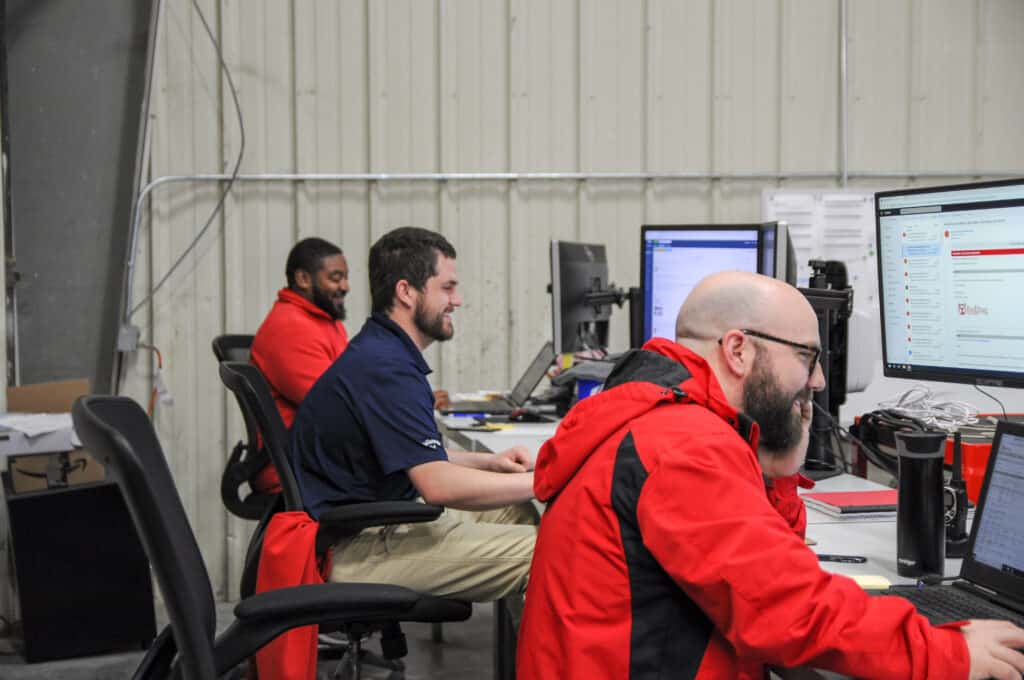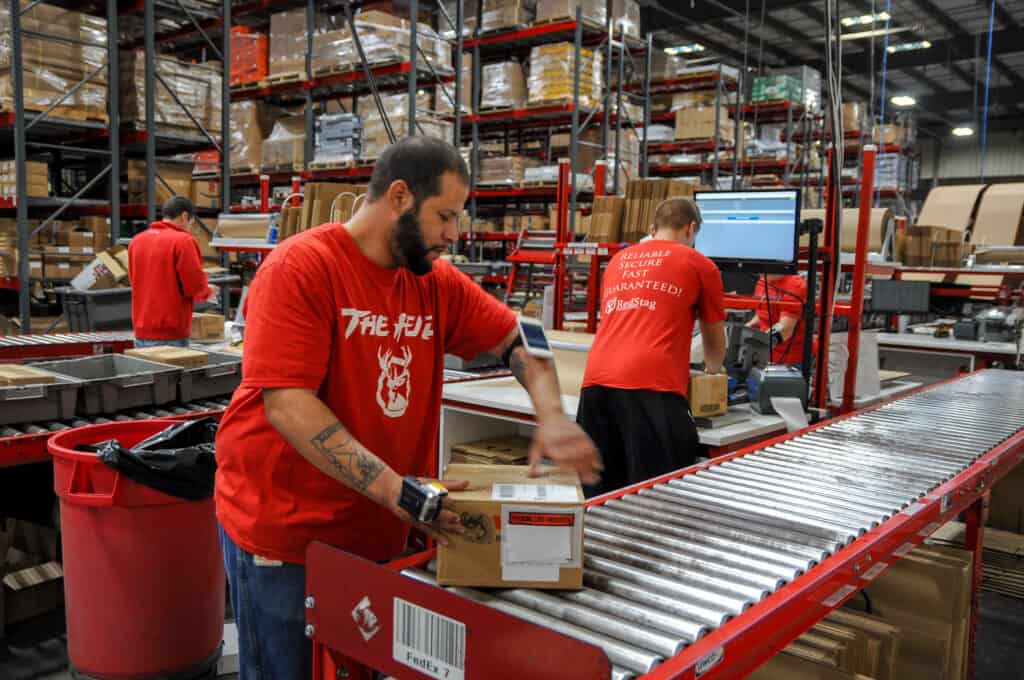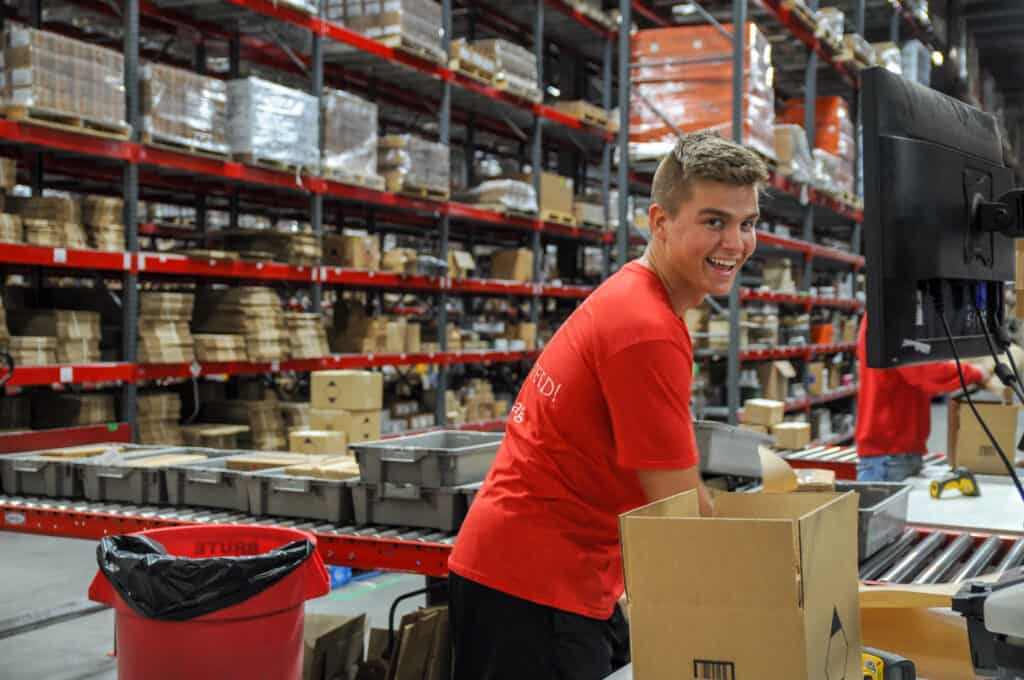If you’re looking for a way to fulfill orders from any channel, Amazon Multi-Channel Fulfillment (MCF) could offer the support your ecommerce business needs, whether you sell on Amazon or not.
Learn how it works and see comparisons with other order fulfillment options.

Nothing in this article is meant to imply a legal relationship between Red Stag Fulfillment, LLC and Amazon. Red Stag Fulfillment, LLC does not own any other company’s trademarks referenced or included in this article.
What is Amazon Multi-Channel Fulfillment?
Amazon Multi-Channel Fulfillment is a third-party logistics (3PL) solution that serves your off-Amazon online sales channels. This includes anywhere else you sell online, like your own website, other ecommerce marketplaces, and social media platforms.
The MCF service lets you use Amazon’s warehousing and distribution network, logistics workforce, and transportation network for your fulfillment. It’s offered as part of the marketplace’s broader Supply Chain by Amazon solution, which automates certain services for businesses that require low operational control.
How does Amazon MCF work?
You begin by allocating inventory to Amazon. This means you send all or a portion of your products to their warehouses based on your business’ distribution tactics.
Amazon uses data from across your product categories to decide how to split your stock across its different fulfillment centers. This helps them get your products closer to customers, making shipping faster and cheaper.
When a customer places an order, Amazon picks the items from its fulfillment centers, packs them for shipment, and delivers the package to your customer. It doesn’t matter what sales channel your customer uses. Amazon takes care of fulfilling orders for you.
Amazon Multi-Channel Fulfillment vs. Fulfillment by Amazon
Amazon MCF is unique because it allows you to fulfill orders from non-Amazon sales channels. In contrast, orders placed within their marketplace use Fulfillment by Amazon (FBA). Just like Multi-Channel Fulfillment, FBA includes warehousing, pick and pack, and shipping.
You don’t have to use Fulfillment by Amazon or even sell products on Amazon to use Multi-Channel Fulfillment. But, Amazon claims using both solutions across channels can increase your Amazon.com sales revenue by an average of 38%.
That’s likely because consolidating your inventory with a single logistics provider can lead to higher stock availability and faster inventory turnover for all channels.
But, achieving that doesn’t necessarily have to be done with Amazon’s fulfillment centers. If you were to consolidate your inventory with another 3PL, you could likely realize similar sales and revenue increases.
Multi-Channel Fulfillment Amazon fees
Fees vary across the two services. Multi-Channel Fulfillment fees can be more than double Fulfillment by Amazon fees. The differences depend on your products’ size tiers, weights, and other pricing factors.
Take a look at the following fee schedules to see what Amazon would charge for your products:

Understanding Amazon terminology
Inventory consolidation is typically part of an omnichannel fulfillment strategy, where you sell on any channel from a unified stock.
But that sounds like Amazon Multi-Channel Fulfillment, right? That’s because Amazon uses the term “multi-channel” to refer to non-Amazon sales channels—even though it’s closer to what the rest of the industry considers omnichannel.
Typically, multi-channel fulfillment contrasts with omnichannel fulfillment. It requires dividing stock instead of consolidating it. You manage each channel separately instead of all under one system.
Want the benefits of a true omnichannel strategy? Work with a 3PL that fulfills Amazon and other orders.
Consolidating inventory in fulfillment centers
Inventory consolidation is when you combine all or most of your products into one warehouse or network of warehouses. This unifies your inventory management, making it easier to monitor stock levels and sell through any channel. It can also allow your fulfillment provider to pick, pack, and ship more efficiently.
Your sales may benefit from pooled inventory, too. Having your inventory in one system means items are more likely to be available when customers want to buy them.

The risks of split inventory
Amazon MCF leverages the benefits of consolidated inventory on your behalf. By bringing your storage, picking, packing, and shipping under one system, you sidestep some of the common risks of selling on multiple channels.
For example, when you store products in different places for different channels, you may split or allocate the wrong amounts of items to the wrong fulfillment center. If you sell out of items from the fulfillment center, you could incur unexpected costs or losses. Here are your options at that point:
- Pay to move products from one fulfillment center to another to meet demand. This would reduce the item’s profit margins and impact fulfillment and delivery times, which could also impact customer satisfaction.
- Lose the sale, which would reduce your inventory turnover rate and almost definitely impact customer satisfaction. You still have to pay carrying costs on the inventory that’s in the wrong place, reducing margins further.
With Amazon Multi-Channel Fulfillment, you don’t have to decide how to allocate inventory. Amazon helps make sure you have enough stock in the right places to fulfill orders quickly and support customer satisfaction. You also get stock recommendations so you can keep up on supplier orders without excessive investments in demand forecasting.
Amazon Multi-Channel Fulfillment service pros and cons
Close to half a million ecommerce businesses use Multi-Channel Fulfillment, but logistics aren’t one-size-fits-all. Consider some of the pros and cons of Amazon MCF to see if it’s right for you.
Amazon MCF pros

Centralized operations across sales channels
Having your inventory in one system lets you centralize all of your order fulfillment operations, including picking, packing, and shipping. These processes can quickly become more efficient, potentially reducing errors and saving you money. By outsourcing the work to Amazon fulfillment centers, you may be able to reallocate internal resources for growth or limit headcount to reduce costs.
Centralized inventory typically means higher data integrity and availability, too. That’s because your inputs come from the same system or network of systems that provide your visibility and reporting. Amazon also offers APIs that connect your online store with data systems for unique insights that reflect your business in real-time.
Pick and pack accuracy
When you outsource fulfillment, you don’t have to worry about setting up quality processes yourself. Amazon claims a 99.8% undamaged package delivery rate based on claims data from small- and medium-sized businesses. With approximately 1.5 million workers across 2,000 warehouses, it also has the labor and resources to provide reliable fulfillment for any size business.
Delivery options
You get three tiers of delivery options for limited control over shipping:
- Standard shipping (5 business days)
- Expedited shipping (3 business days)
- Priority shipping (2 business days)
Amazon also claims more than 97% on-time delivery rates, which is only slightly lower than some competitors.
Transparent pricing
Amazon publishes MCF rate tables for you to calculate fulfillment costs based on your products’ size tiers, weights, and other pricing factors. These don’t include all of the expected fees, but you can use them to estimate your costs and compare them with other fulfillment services.
Amazon MCF cons

Conflicts of interest
Amazon isn’t always on your side. That’s because the dynamics between Amazon and its partners can be complex. There may be times when Amazon prioritizes its role as a marketplace over its role as your fulfillment provider.
For example, at the beginning of the COVID-19 pandemic, consumer demand for essential items was extremely high. Amazon’s workforce was limited and working more slowly than usual due to new safety protocols. As a result, it chose to fulfill only the items experiencing the highest demand and froze non-essential item sales for close to a month.
There may also be times when Amazon limits your ability to sell to other channels by acting as a direct or indirect competitor. For example, a protein bar company suffered broad losses when it didn’t meet a spike in demand for a single item.
When that item sold out, Amazon buried the company’s listings and stopped running its sponsored ads. The brand’s sales dipped by 25%, and its competitors quickly overtook its best-seller category ranking. As a result, the brand sent the majority of its stock to Amazon’s fulfillment network, reducing stock allocation to grocery stores. Amazon’s demands effectively cut off the brand’s other sellers, treating them as competition after already constraining the brand’s ability to sell.
These scenarios may seem rare, especially since they took place during the pandemic, but they are possible. Consider their impact to make the best decisions for your business.
For example, one way to avoid conflict of interest is by diversifying your partnerships. Choosing an independent 3PL can sidestep the risk of a partner constraining your business for their own profit.
Landed cost control
Landed cost is vital to profitability, but you have no control over it with Amazon. When you use the company’s fulfillment services, it manages storage, packing, and shipping.
By comparison, the right-sized fulfillment company can work with you to control costs at each step of the fulfillment process. If Amazon were to provide your ecommerce business with this tailored customer service, its operations would grind to a halt. It has to automate almost everything, which means you don’t get any say in what it costs.
What is landed cost?
Landed cost is the sum of expenses associated with transporting your products from factory floors to customer doors. Order fulfillment is a major contributor to landed cost. That’s why it’s important to optimize costs related to storage, picking, packing, and final-mile delivery.
You can’t necessarily predict fulfillment costs with Amazon, either. Its fee tables are subject to change with only a few weeks’ notice. The company already issued three sets of pricing for FBA fulfillment in the first few months of 2024 alone. It could do the same with its Multi-Channel Fulfillment service at any time.
When fees change, you either have to find ways to offset costs elsewhere or risk letting your profits suffer. This could mean cutting headcount, reducing product quality, or limiting marketing. These reductions can eventually lead to lower profits, anyway, because you’ve eliminated resources you would normally depend on for growth.
Packing material control
Amazon MCF doesn’t allow you to have any control over packaging materials, either, so you can’t control the cost of boxes or infill. If you ship large or bulky items, this can represent a serious gap. Shipment of larger items may be determined by dimensional pricing based on volume. If you can’t optimize packaging, you could be paying too much.
Amazon MCF ships items in unbranded packaging, too. That means customers don’t get Amazon-branded packaging, but they don’t get packages that look like yours, either. You might normally invest in branded packaging, so customers might do video unboxings or talk about your products online. Amazon MCF weakens those opportunities.
Fees for some carrier selections
Some sellers may choose to block Amazon Logistics from their fulfillment services because certain carrier restrictions don’t work for them. In those cases, sellers face a 5% surcharge. At scale, this difference in unit pricing can severely impact landed costs at the SKU level and across your business.
Difficulty forecasting profitability
Fulfilling through Amazon can make profit prediction difficult. For starters, you may not be sure which items will sell on Amazon or other channels. The marketplace makes allocation recommendations, but it may take time to develop certainty around which items are subject to MCF fees and which are subject to FBA fees.
And because Amazon may act more like a competitor than a partner at times, you may have uneven revenue. This may be rare, but it can create cascading effects that could harm your business.
This might also make your SKU analysis more complex. Forecasts may include inaccuracies that impact your supplier order decisions, which impact your ability to meet demand. Without reliable forecasting, it can be risky or difficult to invest in growth.
Amazon MCF might help you grow to a certain point, but because of its overall constraints, your business might eventually plateau.
Amazon Multi-Channel Fulfillment alternatives
Discovering the pros and cons of Amazon Multi-Channel Fulfillment may inspire you to seek alternative or additional services from a 3PL. Here are some to consider.

Customized solutions
A 3PL can help you meet demand on and off Amazon. If you choose a provider that doesn’t have to standardize or automate everything, you can also benefit from tailored solutions that Amazon can’t offer.
Amazon’s fulfillment network can’t slow down its operations to help you with the things that make your business unique. But, the right 3PL can support specific packaging requirements, branding options, kitting, assembly, and other value-added services.
You may also prefer the close customer support of an independent 3PL. Having someone to answer questions and provide insights can help your business grow. Even if you’re shipping tens of thousands of items a month, you can have a personal relationship with your 3PL.
calability
Some 3PLs offer pricing that lets you pay as you go based on what you need. MCF pricing structures are similar in that you pay for what you need, but you lose the opportunities to benefit from volume discounts or other negotiation opportunities.
As you grow into other sales channels, Amazon Multi-Channel Fulfillment can provide you with quickly scalable fulfillment and logistics services, but a 3PL can provide personalized attention to demand planning, inventory management, and cost efficiencies.
Where Amazon’s recommendations can sometimes feel like demands, complete with penalties for non-compliance, a good 3PL partner offers insightful tips while allowing you to maintain control over your own business outcomes.
Learn more about 3PL fulfillment
Want to learn how Red Stag Fulfillment can help you fulfill orders on and off Amazon? Reach out to start a conversation.
More about multi-channel fulfillment:












